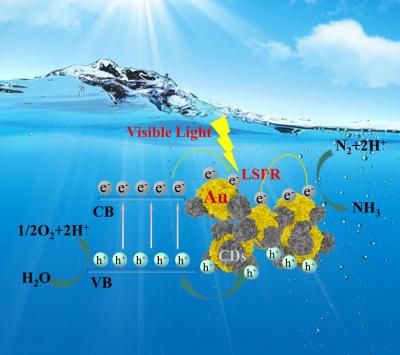
Credit: Author
In a paper published in NANO, a team of researchers from Xinjiang University, China have prepared Au@CDs photocatalyst with core-shell structure by combining coal-based carbon dots (CDs) with gold sol. With its high photocatalytic activity in the synthesis and visible-light photocatalytic N2/H2O to ammonia, this has far-reaching significance for the further development of coal resources to prepare high-performance materials.
Synthesis and visible-light photocatalytic N2/H2O to ammonia at atmospheric pressure and room temperature is considered to be the most ideal ammonia synthesis technology. However, fixing N2 to NH3 under mild conditions remains a major challenge.
In this study, coal-based carbon dots (CDs) were prepared by H2O2 oxidation method using cheap and ubiquitous coal as the carbon source. Then the gold sol was connected to CDs to obtain a core-shell structure photocatalyst Au@CDs by sodium borohydride (NaBH4) reduction method. While characterizing the material structure, the photocatalytic N2/H2O to ammonia performance of Au@CDs was investigated.
The results show that the prepared Au@CDs has higher photocatalytic activity for photocatalytic N2/H2O to ammonia, the yield of Au@CDs photocatalytic N2/H2O to ammonia about 3.5-fold higher than that of bare CDs. Using N2-TPD, UV-Visible, EPR, and electrochemical tests to study the photoelectric properties of the prepared photocatalysts. The photocatalyst Au@CDs prepared by CDs coated with precious metal Au not only improves the carrier performance of the catalyst under visible light but also inhibits the recombination of photocatalyst hole pair, promote the charge transfer ability, and make the photocatalyst and hold move smoothly to the photocatalyst surface. At the same time, it also improves the adsorption and dissociation ability of N2 on the catalyst surface, thus promoting the photocatalytic N2/H2P ammonia synthesis reaction.
This work will contribute to the better design of carbon nanoparticle-coated metal-type photocatalytic materials, which will be of far-reaching significance for the further development of coal resources to prepare high-performance materials. The Xinjiang University team is currently exploring the preparation of more suitable photocatalysts to improve photocatalytic nitrogen fixation for ammonia synthesis.
This work was grateful for the financial support of the National Natural Science Foundation of China (21862020)
###
Corresponding author for this study is Halidan Maimaiti ([email protected]). Additional co-authors of the paper are Ying-dan Cui,Halidan Maimaiti, Shi-Xin Wang,Bo Xu,Hai-zhen Zhang and Pei-shuai Zhai.
For more insight into the research described, readers are invited to access the paper on NANO.
IMAGE
Caption: Synthesis and visible-light photocatalytic N2/H2O to ammonia of Au@CDs core-shell nanocatalyst.
NANO is an international peer-reviewed monthly journal for nanoscience and nanotechnology that presents forefront fundamental research and new emerging topics. It features timely scientific reports of new results and technical breakthroughs and publishes interesting review articles about recent hot issues.
About World Scientific Publishing Co.
World Scientific Publishing is a leading independent publisher of books and journals for the scholarly, research, professional and educational communities. The company publishes about 600 books annually and about 140 journals in various fields. World Scientific collaborates with prestigious organizations like the Nobel Foundation and US National Academies Press to bring high quality academic and professional content to researchers and academics worldwide. To find out more about World Scientific, please visit http://www.
For more information, contact Tay Yu Shan at [email protected].
Media Contact
Yu Shan Tay
[email protected]
Original Source
https:/
Related Journal Article
http://dx.




